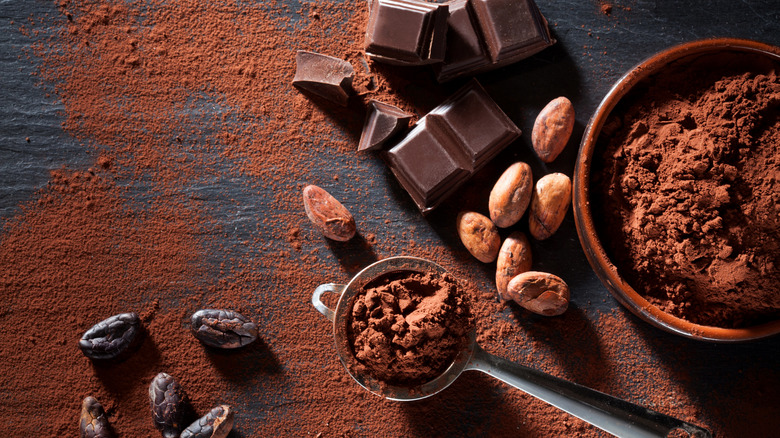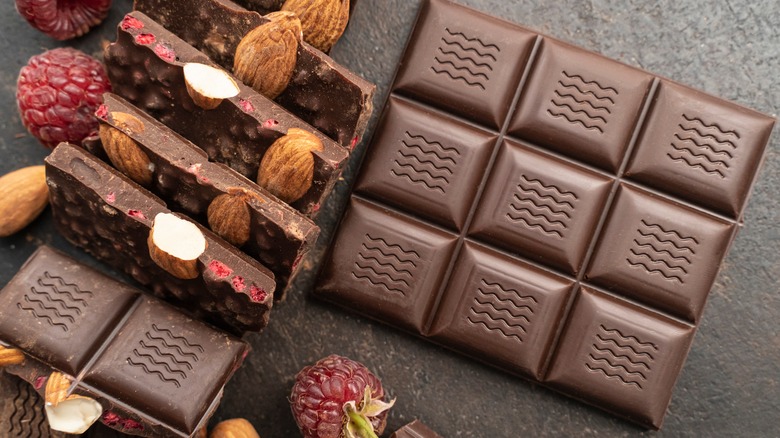The Golden Rule For Eating Chocolate On A Paleo Diet
We may receive a commission on purchases made from links.
Chocolate lovers, unite. With a little planning, you can enjoy your favorite treat and still follow the paleo diet. That's right — chocolate chip cookies, cake, brownies, and other chocolate treats are all okay, as long as you follow some simple rules. But first, make sure you understand what the paleo diet is all about and why some foods are off-limits.
This dietary plan is based on the eating habits of our hunter-gatherer ancestors and, therefore, includes whole foods such as grass-fed meat, wild-caught fish, vegetables, nuts, and seeds. However, you may not eat grains, white potatoes, dairy products, salt, or legumes because these foods were not available in the Paleolithic era. The same goes for coffee, flour, refined vegetable oils, and other processed foods or beverages. Organic red wine is only allowed in small amounts.
The paleo diet may seem restrictive, but its health benefits are backed up by science. For example, a 2009 study featured in Cardiovascular Diabetology found that paleo-style diets may improve glycemic control, cholesterol levels, and insulin sensitivity in people with diabetes. In some cases, it might also lead to weight loss, says the University of California, Davis. The best part is, you can still enjoy a piece of chocolate every now and then without breaking the rules.
Not all chocolate is paleo-friendly
The paleo diet doesn't allow processed foods, including sugar and dairy. Carrageenan and other common food additives are off-limits, too, because they didn't exist in the Paleolithic era. Most types of chocolate contain some or all of these ingredients, such as milk powder, whey, and soy lecithin. Soy is a legume, and because the paleo diet doesn't allow the consumption of legumes, it's best to avoid any foods containing soy lecithin.
Even so, you can still eat chocolate while on the paleo diet. The key is to choose dark varieties with no milk, sugar, or additives. Dark chocolate usually contains at least 50% cocoa solids plus sugar, cocoa butter, and, sometimes, nuts or dried fruit. However, the amount of cocoa solids can go up to 90%, which automatically reduces the amount of added sugar. Ideally, opt for varieties with at least 70% cocoa. By comparison, milk chocolate has only 10% to 50% cocoa solids.
The good news is, many brands are now offering sugar-free dark chocolate or paleo-friendly chocolate bars. For example, the Choco-Zero Store sells 70% dark chocolate with no added sugar or artificial sweeteners. Manufacturers used monk fruit, a paleo-friendly ingredient, to enhance its flavor and aroma. Most importantly, check the ingredient list to make sure there's no sugar, milk, and other extras — even if the label says "dark chocolate," "paleo-friendly," or "sugar-free."
The fewer ingredients, the better
The best dark chocolate for when you're on the paleo diet is one that has the fewest ingredients. For example, Hu Kitchen's Salty Dark Chocolate has just four ingredients: organic cocoa, organic cocoa butter, unrefined organic coconut sugar, and sea salt. Organic coconut sugar comes from the sap of coconut palms, so it fits into the paleo diet. Other dark chocolate varieties may contain almonds, peppermint, ginger, and other paleo-friendly ingredients. Note, though — peanuts, a common ingredient in chocolate, are legumes, not nuts, and, therefore, they're off-limits.
Another option is to make chocolate at home. All you need is cocoa powder, coconut oil, organic coconut sugar or stevia, and natural flavors, such as cinnamon or vanilla. You may also add a small amount of honey for extra sweetness. Likewise, you can make flourless chocolate cake, chocolate cupcakes, muffins, crêpes, and other paleo desserts that look and taste amazing.
Last but not least, remember that dark chocolate is good for you. This bittersweet treat boasts large doses of iron, copper, zinc, and antioxidants, plus dietary fiber, registered dietitian Devon Peart, RD, MHSc, explained to Cleveland Clinic. Due to its high antioxidant content, it supports heart health and cognitive function while preventing age-related cell damage. Peart also recommends dark chocolate for its appetite-suppressing effects. "It signals to your brain that you're satisfied and finished. And it is satiety-inducing, so you are more likely to feel like you've had enough," she said to the outlet.


